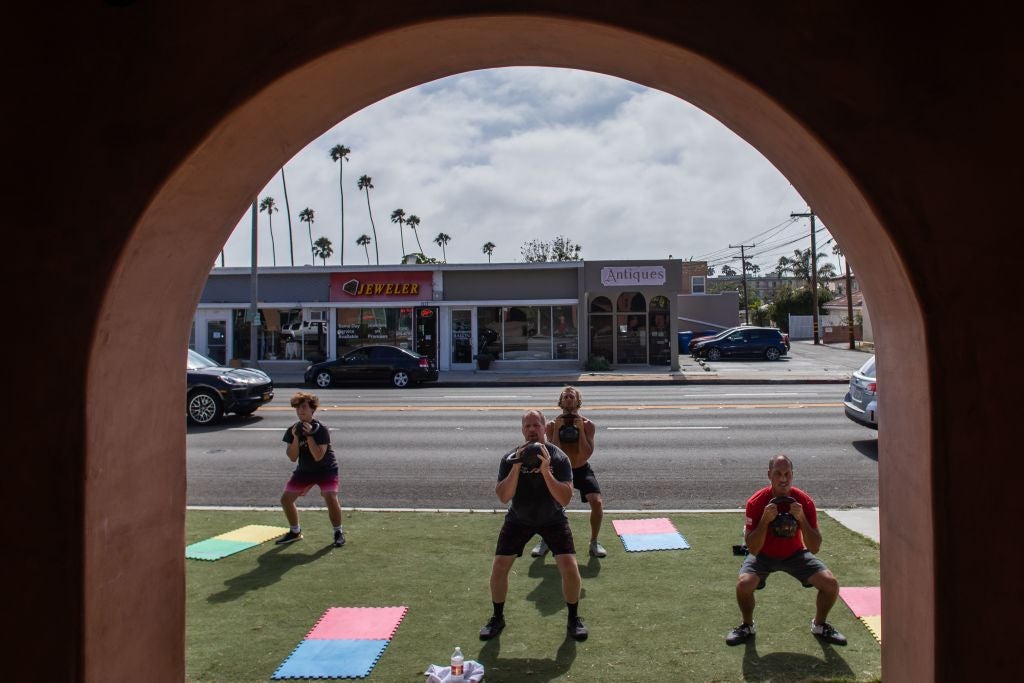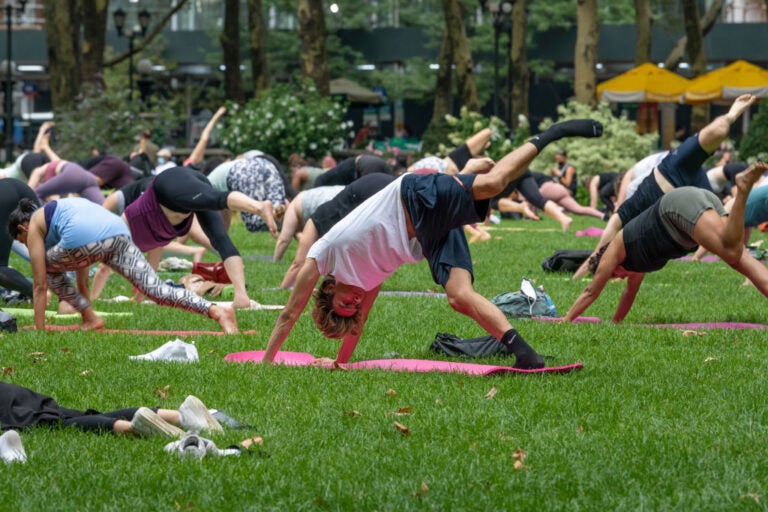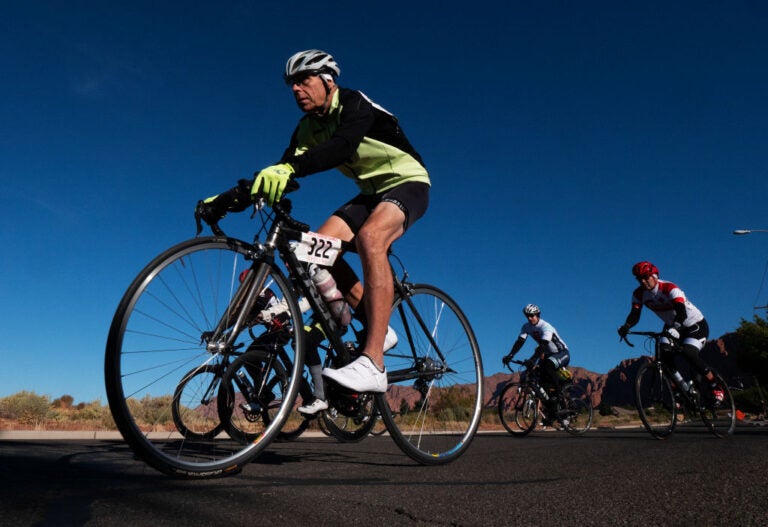Building a Better Movement Culture Will Require Inclusion and Creativity
Why this matters
Building a stronger and more useful fitness culture in the United States will mean leaving behind outdated distinctions between sport and fitness, instead embracing all the best of both worlds to embrace all types of people.
When people learn that I’ve spent nearly a decade researching fitness culture, they tend to respond in a particular and telling way: by recounting their own humiliating experiences with physical education, some so intense that they were turned off exercise for years by the very classes meant to engage them in it.
I can relate, as I, too, was once a gym class anti-hero, more drawn to books than barbells. Today, however, I spend more time than most at the gym, figuratively and literally: I study fitness, teach group classes, and find both exhilarating. My journey from then to now, physically and intellectually, has given me a deeper understanding of the ironies and inequalities surrounding and suffusing American exercise culture – and convinced me that we must begin to bridge longstanding gaps between sports and fitness in order to foster a more enriching movement culture for all.
Leaving P.E. Class Behind
Growing up in suburban Boston, I was intimidated by all things athletic and mostly stuck to what came easily: tearing through novels, filling up journals, and dialing in Top 40 radio requests that I would then capture on cassettes in my boom box. The cavernous gymnasium at my public high school? Not my comfort zone. While there were objectively challenging activities in the curriculum, such as rope climbing or ranked flexibility tests, I remember feeling most intimidated by a physical feat that presented itself before the teacher even blew the whistle: On some days, in a pattern I could never predict to “use my skips”' accordingly, the wooden bleachers would be locked shut and pushed close to the wall. The teacher would expect us to scale up the wooden slats to sit on top and await instruction.
As if Mount Everest might loom behind the gym’s double doors, I prayed each day before class that the bleachers would be open and accessible – or that if they weren’t, my scrawny arms might miraculously be able to hoist the heft of my legs, which teen magazines taught me were too big. I managed to complete the ascent a few times, flustered with embarrassment at my clumsiness as much as the exertion. I eventually found a solution to my discomfort, buried in the student rights and responsibilities manual: an “independent study” in physical fitness, an option the department head told me no one in his memory had ever asked to exercise.
My exit from P.E. became my entry to a mid-1990s fitness culture that was an unlikely place for a bookish teenager. While my friends played sports like soccer and tennis, I fulfilled the independent study – specified only as “supervised” but not a team (no problem!) – by attending a step aerobics class at the Jewish Community Center where my family had a membership. Fortuitously, in a studio of mostly women and some men twice my age, I discovered an entirely new experience of exercise. Spinning around that step, risers stacking higher as I mastered the movements and combinations, I felt exhausted but exhilarated. It was a feeling unlike anything P.E. class or dabbling in basketball and lacrosse had inspired within me. Pretty soon, I was addicted. I saved my allowance to upgrade to a nearby Gold’s Gym; worked behind the desk at a fancy health club during my college years to get the free membership; and ultimately became certified to teach group fitness.
Sorting Out Sports Vs. Fitness
The fitness world was far from perfect, though. The same classes that made me feel like a superhero also taught me that their primary purpose was to “fix” the “problem areas” of my physique that I had previously perceived primarily as body parts. Especially when I began to identify as a feminist, I cringed at the uncritical pursuit of a “bikini body” that dominated so many of these spaces – even as the same spaces brought me genuine joy, as well as a sense of empowerment.
Aglow from class, I would ask myself: Did I feel powerful for what I understood as the “right” reasons of building strength, learning new skills, and protecting my health? Or was my joy simply a function of succeeding within a set of patriarchal rules about how women should look that I had internalized? As a graduate student, this ambivalence hardened into guilt at what I interpreted as my own hypocrisy: I stuffed my spandex and sneakers deep in my backpack when I went to TA Feminist Studies 101, yet I felt both were too intrinsic to my identity to resolve this problem by abandoning either.
For all my ambivalence, so much time at the gym had convinced me of one thing: my physical strength. This confidence, and living for the first time in temperate California, led me to running – which ironically had been the very first athletic activity to intimidate me, when back in preschool a teacher sternly announced that my slowness was holding up the entire class. Walking to my car one day, I noticed a big group of people of all sizes and ages gathering in the sunshine, wearing purple T-shirts and looking surprisingly happy even though, I learned, they were about to run more miles than I could imagine surviving, much less enjoying.
I joined this group – which called themselves a team – and a few months later completed my first marathon. Our conversations were about encouraging each other on our mounting mileage, which trails had clean restrooms and good food nearby, and how to stretch and structure our training around the diverse demands of our lives, which ranged from parenting to dissertating to working across time zones.
There’s no question that I was glad to lose weight as I gained mileage, but I was most impressed that no one was talking about weight loss. Besides, it was the rest of the experience that truly drew me in: training structure, event performance, teamwork, and community. It all felt like a revelation – a revelation, I realized when I excitedly told my former-college-swimmer boyfriend about it, that I might have experienced sooner had I stuck it out in sports as a kid. I had always found it mysterious when people would list athletic accomplishments on their resumes for entirely unrelated careers. But I began to understand the powerful skills and sensibilities such experiences could impart.
Over time, I learned to not lament the lost movement opportunities of my youth, especially when I noticed something curious. Just as I was throwing myself into marathon training, some of my friends who had always been accomplished athletes found it surprisingly difficult to work out without a competition, a coach, teammates, or a training schedule to inspire them. Because I had always had to motivate myself to get moving, often in a room full of much older strangers and for no greater goal than sweating through that individual session, it was relatively easy for me to get moving – and to find it rewarding.
I found it positively thrilling to try new workouts or to cross a finish line of even the smallest neighborhood 5K, regardless of my time. I grinned while teaching early morning classes. A friend diagnosed me with “adult-onset athleticism,” and, joking aside, I think there’s something to that. I loved experiencing – and even enjoying and doing decently well at – activities in a way that still felt so alien to how I fundamentally understood myself. Others who had spent their childhoods engaged in intense and structured sports, however, had a hard time getting excited about fitness activities that seemed inconsequential by comparison. In adulthood, the disjuncture between organized athletics and recreational movement – between what we think of as “sports” and “fitness” – could leave them as disoriented as I had felt in my school gym.
Toward an Inclusive, Healthy Fitness Culture
History helps explain how we got here. In the latter 19th century and much of the 20th century, the boundaries between sports and fitness were starkly and deliberately drawn. Physical education boosters in the 19th century had emphasized how recreational fitness activities such as group dance were distinct from rigorous sport in being gentle and collaborative – and thus appropriate for delicate girls. Well into the 20th century, advocates of sports for boys and men depicted sports such as football as masculine and ennobling in their brutality and competitiveness – in contrast to effeminate activities such as training with barbells for aesthetic ends.
Over time, this opposition evolved but endured. In the 1950s and 1960s, as panic about heart disease among sedentary white collar workers escalated, so did an urgency to promote inclusive fitness activities over sports. “No one gets cut from the squad of fitness,” one federal pamphlet announced in 1960, listing an excessive emphasis on organized athletics as a situation that could endanger community fitness. Sports required skill, after all, and thus left “soft Americans” – as President John F. Kennedy called those who were a civic liability in Sports Illustrated in 1961 – who could most benefit from exercise susceptible to “spectatoritis,” the condition of watching passively from the sidelines. While attempting to transform the public perception of fitness as something fundamentally unserious and even unhealthy, federal fitness boosters ironically enlisted the support of sports celebrities such as football coach Bud Wilkinson.
Striking a very different note but equally invested in this boundary, some feminists in the 1970s celebrated the radical potential of women’s sports because they entirely rejected the beauty objectives of the body work offered at slenderizing spas and health clubs. Women who promoted fitness programs also embraced this distinction, enticing clients to participate in aerobic dancing programs that caused participants to break a sweat without building the physical “bulk” or “aggressive character” that supposedly defined a sportswoman. Efforts to meld the two, like the non-competitive “yoga-tennis” piloted at the countercultural Esalen Institute, were considered hippie diversions. In 1979, cultural critic Christopher Lasch scoffed at the “degradation of sport” from an elite art form to come-one, come-all recreation. Meanwhile, slavish devotion to this distinction caused sports apparel giant Nike to largely miss out on the lucrative aerobics boom of the 1980s: Nike outfitted athletes, executives insisted, not “a bunch of fat ladies dancing to music.”
Related: What We Can Learn From the Harmful Body-Shaming Culture Around the University of Oregon Track Program
By the 1990s, however, these boundaries became more fluid. Title IX meant girls of my generation were the first to know only a world in which the federal government guaranteed our access to sports. Players from the World Cup-winning U.S. women’s national soccer team filled the pages of health and fitness magazines, lauded for their athletic achievements and held up as exemplars of a more muscular – if still narrowly defined – beauty ideal. Group fitness classes welcomed more men to programs that integrated martial arts and sports drills in a less-restrained pursuit of muscle. The step classes I loved, which included weights, were a prime example, as was an ad for a new cardio kickboxing certification that promised to attract “a lot of men who would not be caught dead in a fitness studio.” Even my dreaded P.E. classes, which still had vestiges of Cold War militarism and traditional sports programming, showed signs of evolving by including activities such as yoga, foursquare, and free play.
However, this boundary-crossing has yet to yield many positive gains. Yes, it was a coup that a more broadly-accepted athleticism expanded beauty ideals to include more muscular bodies, but for me and many others, this mostly meant chasing yet another aesthetic ideal – buns and abs of steel – as opposed to building strength, skill, or self-confidence. Similarly, the inclusivity of recreational fitness has hardly infiltrated sport in a transformative way. In the past two decades, the hyper-specialization and high stakes of youth athletics have only intensified. Experiences such as that of elite runner Mary Cain, who was driven to disordered eating by coaches unapologetically telling her to be “thinner, thinner, thinner,” surely affect less famous figures, especially as girls are now expected to be athletic on top of the other social pressures they have long shouldered. Suffusing fitness with the spirit of sport, and vice versa, could be a powerful way forward, but that path must be deliberate.
So, how do we move toward a more just and inclusive movement culture? There is rightly lots of talk about “access,” whether to sports or fitness environments that have long discriminated based on race, class, gender, size, and ability. But it is crucial to define what we are fighting for access to, and where it might exist. Is it really a win to have more people chasing a “perfect” body or a championship trophy? What does it mean that public school physical education, the place where Americans are most likely to first – and freely – encounter exercise, has too often alienated participants and is often a low priority in cash- and time-strapped schools? A useful answer to these questions begins with understanding how and why sports and fitness have always had a close but uneasy rapport and recognizing the role physical education has to bridge this artificial distinction in ways that allow individuals and groups to thrive. Scholars of sport and fitness, physical educators, and fitness professionals, who too rarely occupy each others’ intellectual and professional universes, could play a powerful, collaborative role. Imprecise calls for “access” – or facile celebrations and condemnations of either sports or fitness as unique or superior – miss an opportunity to build a more robust movement culture that intentionally draws from each, as likely to include baseball as barre, in service of creating inclusive, empowering, strengthening, experiences of exercise for everyone, in school gyms and beyond.
Monthly Issue
Sport & the Body
The body is the most fundamental component of sport, capable of unthinkable feats and requiring considerable care. Athletes continually push their bodies to the brink in order to excel at their craft, and the 21st century has brought about a reimagining of the limits of physical ability.
Yet as the world of sport intensifies its focus on the body, athletes are demanding better care, more freedom, and increased flexibility around how they maintain and shape theirs.




